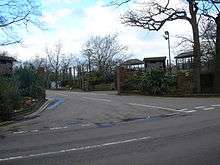Paradise Wildlife Park
 | |
| Date opened | 1960s |
|---|---|
| Location |
White Stubbs Lane Broxbourne, Herts EN10 7QA |
| Coordinates | 51°44′32″N 0°03′14″W / 51.742124°N 0.053988°WCoordinates: 51°44′32″N 0°03′14″W / 51.742124°N 0.053988°W |
| Website | http://www.pwpark.com/ |

Paradise Wildlife Park is a family-run animal park located in Broxbourne in Hertfordshire, England. It was previously known as Broxbourne Zoo, but became Paradise Wildlife Park under the new management of the Sampson Family in 1986.
History
Origins of the zoo
The park was previously known as Broxbourne Zoo,[1] which opened in the early 1960s.
In 1984, the Sampson Family purchased the site with the intention of re-housing the animals into larger enclosures which mimicked their natural habitat, making them as comfortable as possible. The zoo was closed down for two years to undergo this transformation, and re-opened as 'Paradise Park and Woodland Zoo', which was then shortened to Paradise Wildlife Park (PWP).
Since the Sampson family took over the Zoo, the team at PWP have continually researched, expanded and improved upon the animals' living conditions. Paradise Wildlife Park has developed a reputation through its conservation efforts, including The Wildlife Heritage Foundation (the sister site in Kent) which specialises in research and breeding of endangered species.
The Sampson family's work did not stop here though, to achieve their dream of turning their Zoo into a widely acclaimed wildlife park at the forefront of species conservation still needed more to be done. Their hard work and investment to improve the animal enclosures and public facilities, and their drive to enhance the public perception of Paradise Park and Woodland Zoo continued throughout the 1980s. The second stage of development included building new animal paddocks, improving the pathways and increasing tree planting around the site.
Late 80's and 90's
The Sampson family demonstrated their commitment to the project by selling their ‘Sampson Coaches and Buses' company in 1989 and ‘MOT testing centre and garage' in 1990 to allow them to concentrate solely on the management and finance of Paradise Park and Woodland Zoo.
It was the 1990's when the family's dream really started to take shape. The changing of the sites name to ‘Paradise Wildlife Park' signaled a new beginning of an increasingly brighter future for the site. This decade was vital to the development of the Park in all aspects; with the introduction of more spacious open enclosures, perhaps the most significant of which was the unveiling of ‘Tiger Lodge' a new purpose built enclosure for Bengal & Siberian tigers in 1994; and positive changes such as the move towards many ‘hands on' activities with the animals at the Park and an extensive on-site and off-site education programme. Three new themed adventure playgrounds were also introduced to make a day out at the site even more memorable for visiting families. All facilities at the site were given modern renovations, and changes were made to better accommodate and fulfill the needs of disabled people, with the happiness of the parks visitors of paramount importance. Unsurprisingly with each improvement visitor numbers to Paradise Wildlife Park soared.
It was during this time that Paradise Wildlife Park became ‘Hertfordshire's Number One' (purchase ticket) visitor tourist attraction.
2000 and beyond
Paradise Wildlife Park, like many animal attractions, was forced to close (for the first time ever) by the Foot and Mouth epidemic in the spring of 2001.
The new Millennium has witnessed a continuation in the improvements to Paradise Wildlife Park. New enclosures for meerkats, otters, Brazilian tapir, Red panda and European wolves have been assembled. Major work has been done to create new sections; ‘Squirrel Monkey Island', ‘Wonders of the Rainforest', ‘Cheetah Retreat' and ‘Toucan House'. The ARC (Animal Resource Centre) is a new development which houses a veterinary and recovery room, animal food preparation areas, an animal records and research room, and impressive staff facilities. There has been extensive work completed on the paddock areas to improve drainage; much needed overflow car parking facilities have been added; improvements to the water supply. New electricity sub-station and back-up generator have all been new additions to this decade. Paradise Wildlife Park has also introduced ‘The Special Place' a brand new play area adapted for use by children with disabilities.
In 2001, in keeping with their passion for wildlife conservation (Parkside Leisure, the parent company of) Paradise Wildlife Park purchased the site of the Big Cat Foundation in Kent. This was at that time a sanctuary operated by the Born Free Foundation. A new organisation was established by Paradise Wildlife Park called the Wildlife Heritage Foundation.[2] During 2002 the Born Free Foundation and the Wildlife Heritage Foundation held a joint Dangerous Wild Animals Licence to operate the site. The site is now exclusively operated by the Wildlife Heritage Foundation (WHF), (registered charity number 1104420). The objective of WHF is to support conservation in-situ and ex-situ projects and to assist with endangered species breeding programmes. Paradise Wildlife Park financially supports WHF.
Animals
Paradise Wildlife Park is home to over 400 animals, which include small mammals, paddock and farmyard animals, birds, primates, reptiles, and big cats. They house Siberian tigers, White Bengal tigers, South African cheetahs, snow leopards, ocelot and a jaguar. They also house white lions.[3]
Breeding at Paradise Wildlife Park has been successful, with the breeding of endangered species such as marmosets, tamarins, Burmese pythons and lovebirds. Many animals are bred as part of the EEP Breeding Programme.
Animals and wildlife at Paradise Wildlife Park are separated into several attractions including:
- Big cat territory


The big cat territory contains some of the most endangered big cat species in the world, including the White Tiger, Cheetah, Ocelot, White Lions, Snow Leopards, Jaguars and Amur Tigers.
- Hooves and humps
The hooves and humps section houses Ungulate animals such as the endangered Bactrian Camel, the African Plains Zebra, the Brazilian Tapir and Santa’s main helpers the Reindeer.
- Farmyard
The zoo has a variety of species of farmyard animals including pygmy goats, sheep, pigs and chickens among others. Most of the farmyard animals are also able to be fed by hand.
- Tropical rainforest

Paradise Wildlife Park is home to the largest collection of small monkeys in the UK in its natural tropical rainforest house, including over 10 species of small monkeys as well as sloths, armadillos and several other tropical creatures.
- Angkor reptile temple
The Angkor Reptile Temple which houses the largest Anaconda in the UK, Optimus Prime.[4] The zoo also offers over 35 different species of snakes, lizards, spiders, alligators, bugs & beetles.
- Birds & aviary
The Birds at Paradise are an array of vibrant colours, shapes and sounds with macaws, owls, eagles and lorikeets that can be hand fed.
- Small mammals
Paradise are home to a large collection of small mammals including meerkats, red pandas, otters and wallaby.
Animal experiences and attractions
In addition to wildlife exhibitions, Paradise Wildlife Park also offers a range of animal experiences to visitors
Feed the wolves
Paradise Wildlife Park is one of only a few places in the UK to offer the unique opportunity to hand feed wolves. After a full health and safety briefing they offer the opportunity to hand feed one of their two sets of wolves through the mesh of the enclosure. Throughout the experience the keepers will tell visitors interesting facts about the wolves at the Park and the conservation work that is carried out.
Junior zookeeper
This is an experience for adults, children or a family group to become zookeepers. Each day is unique depending on what is going on at the zoo. Visitors may be asked to help out in the farm yard, tidy the wallaby enclosure or work with another type of animal.
Tickle a tapir
This is an experience where visitors get up close and personal with tapirs as they lay at their feet waiting to be tickled. Experience the docile nature of these odd looking creatures and be taught all about them by one of the large mammals keepers
Meet the Meerkats
Join the zookeepers inside one of the meerkat enclosures to meet the little creatures. Equipped with a feeding bowl visitors can get up close and personal to feed the meerkats.
Meet the lemurs
Paradise Wildlife Park allows guests to see the inquisitive nature of these interesting animals. The lemurs can jump on visitors' shoulders and backs whilst taking food straight from their hands!
- Snooze at the Zoo
Snooze at the Zoo is a fully immersive experience that allows visitors to go behind the scenes and stay overnight at Paradise Wildlife Park. During the stay visitors receive VIP wristbands which entitles them to free entry to the park for 2 days, free games of crazy golf, rides on the woodland railway and free animal feed bags.
- Jungle Sleepovers
Jungle Sleepovers are in place for school trips,[5] birthday parties, scouting and guiding groups.
Young groups can stay over night in the Discovery Centre or Marquee, which includes a meet and greet with some creatures, after hours guided tours and refreshments. After an animal filled evening they’re woken up by the morning roar of the lions before gaining exclusive access to the woodland walk and play areas and a jungle breakfast in the Safari Suite. Guests then have free reign to explore over 400 animal.
- Feed the big cats
The experience of feeding either a white lion, snow leopard, jaguar, amur tiger or white tiger. A member of the Paradise big cat team will greet and escort those feeding a Big Cat to the big cat enclosure where the person on the experience will receive an important health and safety briefing. The big cat team will then be on hand to guide the customer through this experience with these awe inspiring cats. Once positioned safely the guest will feed the chosen Big Cat through the bars of their enclosure.
- Big cat breakfast
This is an informative and exclusive tour of our Big Cats before the Park opens to the public followed by a continental breakfast overlooking the Tigers at one of the only places in the UK to offer this experience. During your experience they will teach all about our cats here and the conservation work carried out at both parks.
- Snow leopard champagne breakfast
The Snow Leopard Champagne Breakfast consists of a guided tour of the Big Cat Territory where guests will find out about the big cats at Paradise, finishing at the Snow Leopards where they offer the chance to hand feed them through the mesh of the enclosure! They then offer a Champagne Breakfast at Tiger Tree Tops which overlooks the Tiger Enclosure.
- Tiger tea
The Animal Park will take the visitor on a walking tour of Big Cat Territory to see the big cats housed at paradise, including White Lions, White Tiger, Tigers, Jaguars and Snow Leopards. During the tour the keeper will tell the visitor about the characteristics of each cat and information on the species. The tour will take you along the cat walk, a raised platform boasting spectacular aerial views of the enclosures.
References
- ↑ "Creating Paradise in Broxbourne". Hertfordshire. Retrieved 2016-10-07.
- ↑ "Home - The Big Cat Sanctuary | Wildlife Heritage Foundation". The Big Cat Sanctuary | Wildlife Heritage Foundation. Retrieved 2016-10-07.
- ↑ Paradise Wildlife Park
- ↑ "IS THIS THE BIGGEST ANACONDA IN THE UK?". abcmagazines.blogspot.co.uk. Retrieved 2016-10-07.
- ↑ "Paradise Wildlife Park". www.ukschooltrips.co.uk. Retrieved 2016-10-07.
External links
| Wikimedia Commons has media related to Paradise Wildlife Park. |
